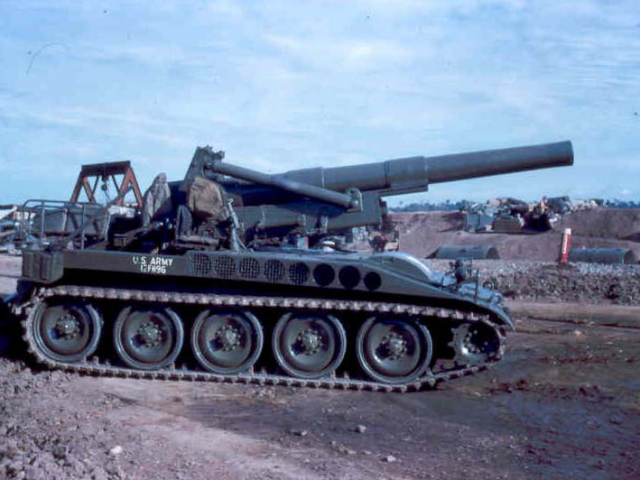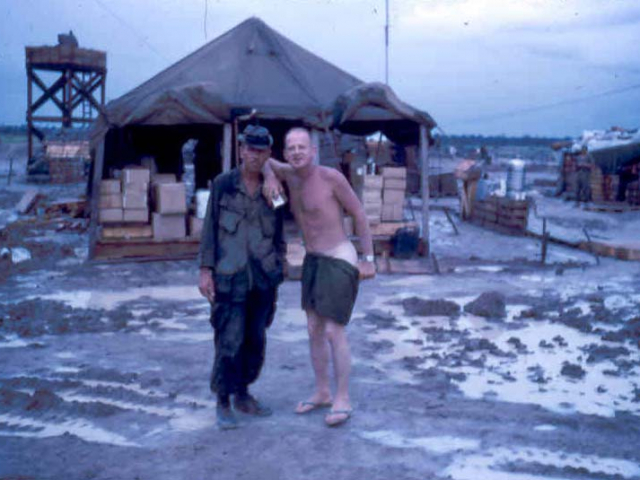Frontier City 1969
The concept of a patrol base on the border had been proven. It was at once an agonizing temptation to the 271st and 272nd NVA regiments on the border and a completely effective deterrent to their infiltration. The enemy was incensed.
On the 24th of April 1969, ten days after the attack on Diamond III, a new patrol base was established by the 4th Battalion, 9th Infantry Manchus one and one half miles north of the "Angle's Wing" along the Cambodian border. In that flat open area, Charlie Company, with Alfha Company supporting, was to build and hold a tiny new patrol base to be named "Frontier City."
On the morning of the 24th, both companies began, with the aid of engineers and artillery personnel, to line out the perimeter of their postion. Using heavy explosives, the troops blew a symmetrical pattern of holes around the perimeter and began to cut them and shape them into hardened fighting positions. Steel plate and bems were flown in as concertina wire was strung out at intervals beyond the bunker line. A CH-54 Flying Crane airlifted a bulldozer in as another dozer was floated down the nearby river on a raft. The area was cleared around the position to give the men the best possible fields of fire. A pre-fabricated tower was lowered into position at the center of the base and two 105mm howitzers were flown in from 7th Battalion, 11th Artillery to provide organic artillery support. Communications were established and, as darkness gathered, the men settled down to wait.
Frontier City was not hit the first night. The enemy was spotted moving in small groups around the perimeter and engaged with artillery, but there was no attack. On the following day Alfha Company made local security patrols and the heavy bulldozers were moved out of the area.
At dusk on the 25th, the enemy made his move. Small groups were spotted moving to the northeast. The decision was made to hold fire, let the situation develop. By 9:00 p.m. enemy movement was being detected as close as 1000 meters as enemy units positioned rocket propelled grenade launchers and ammunition. Heavy movement began just before midnight to the northeast and an entire enemy platoon was spotted shuffling for position in the woodline. That was the time to make the move.
Flare burst overhead; the bunker line touched off railroad flares and smudgepots to mark their position and two Cobra gunships from Bravo Company, 25th Aviation Battalion rolled in.
Artillery was coordinated from Fire Support Bases east of Frontier City and soon whole sections to the south were brought under heavy fire.
Major Harry Ray, the base commander, then ordered the two 105mm howitzers to fire 360 degrees around the base with cannister rounds. The artillery began. The enemy had been caught halfway between his safety areas and the patrol base.
Shortly after midnight the first enemy rounds began raining in on Frontier City. Twenty 107mm rockets and more than 250 82mm motar rounds fell on the base to provide cover for the assaulting enemy sappers. Gunships from the 25th Aviation Battalion and 3rd Squadron, 4th Armored Cav began sweeping areas of enemy activity, dodging the enemy artillery as best they could. Heavy Air Force gunships circled the base on high spitting down a cone of fire, and artillery men on every available gun in the Division's area of operation swung their tubes around and began firing in defense of the position.
Then came the quiet; the shift of fires. Just like Diamond III. The enemy had moved to the edge of the base and was about to assult. The Manchus scrambled out of their bunkers to meet the oncoming sappers with rifles and machine guns. At one point company commander Captain Ramon T. Pulliam rushed to the bunker line and manned an M-60 at the height of the enemy assualt. "When we saw him take over that '60," said PFC Floyd Sinclair of Union, S.C., "it made us want to fight that much more."
The enemy staged a battalion-sized attack from the south where they blew a portion of the wire with bangalore torpedoes. Immediately claymore mines were detonated in the spot and the two 105mm howitzers were fired point blank into the charging NVA. The enemy had been stopped. The fight shifted again, and the rout of the enemy began.
Air strikes were called in to supplement heavy artillery and gunships fired throughout the area. The enemy struggled to get back out of the trap but to no avail. One US soldier was wounded, 214 enemy were eliminated, and 47 weapons were captured.
(This is from the 1969 25th Division Yearbook)
According to records I obtained from the National Archives, FSB Dallas was torn down and Frontier City was established April 24, 1969. Charlie Co. tore down Frontier City, with Delta Co. providing security, May 14, 1969. Frontier City, being a patrol base not a FSB, was only around from April 24 - May 14; or 3 weeks. After the battle, Alpha and Charlie Co.'s rotated to another FSB. Alpha went to Stoneman and stayed there until they went to Mole City June 1. Charlie went to Mole City for 10 days and then back to Frontier City until it closed. Bravo took Alpha's place at Frontier City and Delta was there until Charlie returned on May 7th.
Mike Smith
Co. D 4/9 69/70
Frontier City 1969 Photos
First 9 photos below by: MSgt Charles Stebbins (S-2 NCO) 1969
Click on an image below to view full-sized version.










